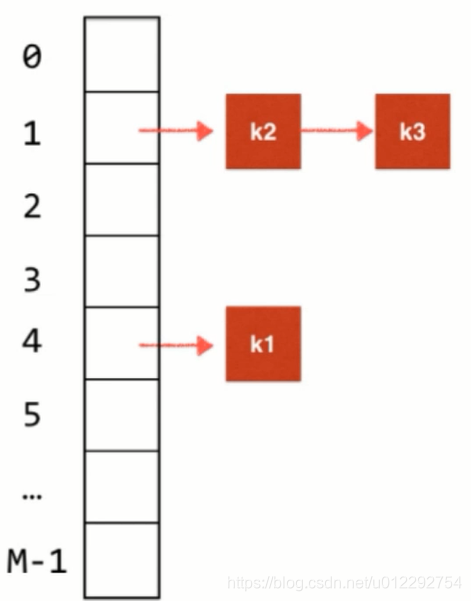版权声明:本文为博主原创文章,未经博主允许不得转载。 https://blog.csdn.net/u012292754/article/details/87189329
1 哈希表复杂度分析(链地址法)
一共有 M 个地址,如果放入的总元素个数是 N
- 如果每个地址是链表,O(N / M)
- 如果每个地址是平衡树:O(log( N / M))

2 哈希表的动态空间处理
- 当平均每个地址承载的元素超过一定程度,即扩容,
N / M >= upperTol - 当平均每个地址承载的元素少过一定程度,即缩容,
N / M < lowerTol HashTable.java
package hashtable;
import java.util.TreeMap;
public class HashTable<K, V> {
private static final int upperTol = 10;
private static final int lowerTol = 2;
private static final int initCapacity = 7;
private TreeMap<K, V>[] hashtable;
private int M;
private int size;
public HashTable(int M) {
this.M = M;
size = 0;
hashtable = new TreeMap[M];
for (int i = 0; i < M; i++) {
hashtable[i] = new TreeMap<>();
}
}
public HashTable() {
this(initCapacity);
}
private int hash(K key) {
// 负数可以变成正数
return (key.hashCode() & 0x7fffffff) % M;
}
public int getSize() {
return size;
}
public void add(K key, V value) {
TreeMap<K, V> map = hashtable[hash(key)];
if (map.containsKey(key)) {
map.put(key, value);
} else {
map.put(key, value);
size++;
if (size >= upperTol * M) {
resize(2 * M);
}
}
}
public V remove(K key) {
TreeMap<K, V> map = hashtable[hash(key)];
V ret = null;
if (map.containsKey(key)) {
ret = map.remove(key);
size--;
if (size < lowerTol * M && M / 2 >= initCapacity) {
resize(M / 2);
}
}
return ret;
}
public void set(K key, V value) {
TreeMap<K, V> map = hashtable[hash(key)];
if (!map.containsKey(key)) {
throw new IllegalArgumentException(key + "not exist");
}
map.put(key, value);
}
public boolean contains(K key) {
return hashtable[hash(key)].containsKey(key);
}
public V get(K key) {
return hashtable[hash(key)].get(key);
}
private void resize(int newM) {
TreeMap<K, V>[] newHashTable = new TreeMap[newM];
for (int i = 0; i < newM; i++) {
newHashTable[i] = new TreeMap<>();
}
int oldM = M;
this.M = newM;
for (int i = 0; i < oldM; i++) {
TreeMap<K, V> map = hashtable[i];
for (K key : map.keySet()) {
newHashTable[hash(key)].put(key, map.get(key));
}
}
this.hashtable = newHashTable;
}
}
3 更复杂的动态空间处理
- 2 * M 不是素数
- 解决方式:按照下表扩容

HashTable.java
package hashtable;
import java.util.TreeMap;
public class HashTable<K, V> {
private final int[] capacity = {
53, 97, 193, 389, 769, 1543, 3079, 6151, 12289, 24593,
49157, 98317, 196613, 393241, 786433, 1572869, 3145739, 6291469,
12582917, 25165843, 50331653, 100663319, 201326611, 402653189,
805306457, 1610612741};
private static final int upperTol = 10;
private static final int lowerTol = 2;
private int capacityIndex = 0;
private TreeMap<K, V>[] hashtable;
private int M;
private int size;
public HashTable() {
this.M = capacity[capacityIndex];
size = 0;
hashtable = new TreeMap[M];
for (int i = 0; i < M; i++) {
hashtable[i] = new TreeMap<>();
}
}
private int hash(K key) {
// 负数可以变成正数
return (key.hashCode() & 0x7fffffff) % M;
}
public int getSize() {
return size;
}
public void add(K key, V value) {
TreeMap<K, V> map = hashtable[hash(key)];
if (map.containsKey(key)) {
map.put(key, value);
} else {
map.put(key, value);
size++;
if (size >= upperTol * M && capacityIndex + 1 < capacity.length) {
capacityIndex++;
resize(capacity[capacityIndex];
}
}
}
public V remove(K key) {
TreeMap<K, V> map = hashtable[hash(key)];
V ret = null;
if (map.containsKey(key)) {
ret = map.remove(key);
size--;
if (size < lowerTol * M && capacityIndex - 1 >= 0) {
capacityIndex--;
resize(capacity[capacityIndex]);
}
}
return ret;
}
public void set(K key, V value) {
TreeMap<K, V> map = hashtable[hash(key)];
if (!map.containsKey(key)) {
throw new IllegalArgumentException(key + "not exist");
}
map.put(key, value);
}
public boolean contains(K key) {
return hashtable[hash(key)].containsKey(key);
}
public V get(K key) {
return hashtable[hash(key)].get(key);
}
private void resize(int newM) {
TreeMap<K, V>[] newHashTable = new TreeMap[newM];
for (int i = 0; i < newM; i++) {
newHashTable[i] = new TreeMap<>();
}
int oldM = M;
this.M = newM;
for (int i = 0; i < oldM; i++) {
TreeMap<K, V> map = hashtable[i];
for (K key : map.keySet()) {
newHashTable[hash(key)].put(key, map.get(key));
}
}
this.hashtable = newHashTable;
}
}
4 哈希表
- 均摊复杂度为 O(1)
- 牺牲了 顺序性

5 自定义的哈希表的 bug

5.1 Java8 中的哈希表
- Java8 之前每一个位置对应一个链表;Java8 开始,当哈希冲突达到一定的程度,每一个位置从链表转成红黑树;
- 因为初始的是链表,所以不要求 K 是 Comparable;
- 转成红黑树的条件:K 是 Comparable,否则依然保持链表;